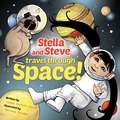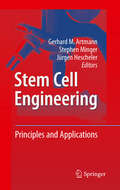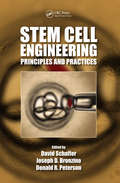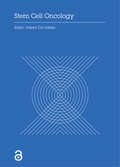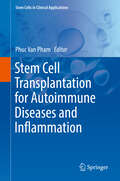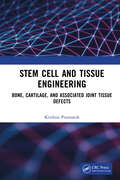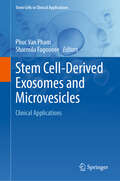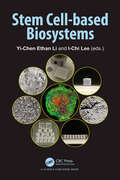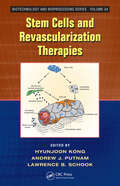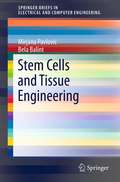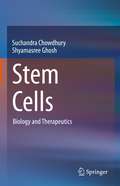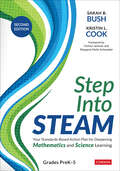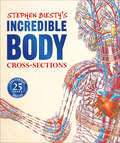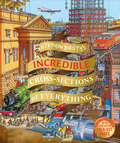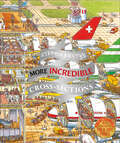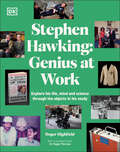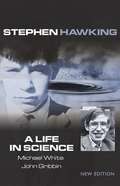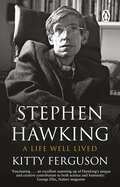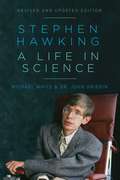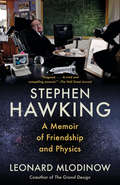- Table View
- List View
Steigerung der Intelligenz mechatronischer Systeme (Intelligente Technische Systeme – Lösungen aus dem Spitzencluster it’s OWL)
by Ansgar Trächtler Jürgen GausemeierDas Buch beschreibt die Ergebnisse des Querschnittsprojekts „Selbstoptimierung“ des vom BMBF geförderten Spitzencluster-Projekts „Intelligente Technische Systeme OstWestfalenLippe“ (kurz: it’s OWL).Die Entwicklung der Informations- und Kommunikationstechnik eröffnet neue Perspektiven für intelligente technische Systeme, die hohen Kundennutzen stiften. Diese Systeme sind in der Lage, sich ihrer Umgebung und den Wünschen ihrer Anwender im Betrieb anzupassen. Für den Innovationssprung von der Mechatronik hin zu selbstoptimierenden Systemen wird Expertise aus den Gebieten Maschinelles Lernen, mathematische Optimierungsverfahren, Regelungstechnik und Condition Monitoring benötigt.Zielsetzung des Cluster-Querschnittsprojekts Selbstoptimierung war ein Instrumentarium zur Planung und Entwicklung von selbstoptimierenden Produkten und Produktionssystemen. Dieses soll die Entwickler in den Unternehmen bei der Realisierung von Ansätzen der Selbstoptimierung praxisgerecht unterstützen. Das vorliegende Buch stellt das erarbeitete Instrumentarium mit den entsprechenden Schwerpunkten im Detail vor. Dabei werden die wesentlichen Grundlagen der jeweiligen Fachgebiete gezeigt und die methodische Umsetzung anhand von Praxisbeispielen aus dem Spitzencluster erläutert.
Stella and Steve Travel through Space!
by Bethany Straker James Duffett-SmithDid you know that Jupiter is eleven times the size of Earth? The solar system is an incredible place that is still mostly unexplored. So, when Stella and her family move to a new town-where Stella has no friends except for her dog Steve-she goes exploring. In this educational book, travel across the solar system with Stella and Steve as Stella looks for a new home on another planet and imagines what life would be like on another world, from Mercury to Pluto. But along the way Stella learns that Venus has acid rain and Neptune is made entirely of gas, and she begins to wonder whether Earth might actually be the perfect home for her after all.Featuring a fun and informational story from author James Duffett-Smith, and bold, comic book style illustrations by Bethany Straker, Stella and Steve Travel Through Space shows just how great the Earth is (while providing young children with an early science lesson) in a twist on "there's no place like home." A quirky but education book on the solar system (with slight undertones of conserving the Earth), this book for children ages 3 to 6 is sure to find a home in preschool and Kindergarten classrooms as well as home across the globe. Parents will love the science information throughout and kids will instantly connect with Stella and her suave pug Steve. Children will learn the basics about the solar system, the various planets, and why we are able to live on Earth so well.
Stem Cell Engineering
by Jürgen Hescheler Stephen Minger Gerhard M. ArtmannThe potential of stem cells for healing and disease prevention in all fields of medicine is tremendous and has revolutionized the high-tech biomedical research. In this book, many of the most prominent researchers discuss the challenging topics of stem cell engineering, for example: Ethical issues of stem cell research; technological challenges, stem cell growth and differentiation, therapeutic applications, bioreactors and bioprocesses, high throughput and microfluidic screening platforms, stem cell identification and sorting, intercellular signaling and engineered niches, novel approaches for embryonic and adult stem cell growth and differentiation, stem cells and drug discovery, screening platforms. Stem Cell Engineering offers valuable background and reference for both the public and professionals including industrial staffers, faculty, researchers, engineers, students and scientific journalists.
Stem Cell Engineering: Principles and Practices
by Joseph D. Bronzino Donald R. Peterson David SchafferWhile the potential of stem cells is recognized, their proliferation and differentiation must be more precisely controlled to maximize the production of therapeutically relevant cells and for cell replacement therapies to minimize contamination with residual cells that can give rise to side effects. With contributions from pioneers and experts, this book provides a broad overview of the challenges of stem cell engineering. It discusses advances made during the last decade that have led to increasingly defined culture systems for growing human ES cells, starting from co-culture with feeder cells in the presence of serum to growth on synthetic substrates in defined medium. The book highlights recent advances in the understanding of the cellular and molecular composition of the hematopoietic stem cell niche, as well as approaches to build upon this basic information to direct stem cell differentiation into blood cell lineages.
Stem Cell Oncology: Proceedings of the International Stem Cell and Oncology Conference (ISCOC, 2017), December 1-2, 2017, Medan, Indonesia
by Adeya AdellaStem cell research is one of the fascinating areas of contemporary biology, but, as with many expanding fields of scientific inquiry, research on stem cells raises scientific questions as rapidly as it generates discoveries. Research on stem cell treatment continues to advance knowledge about how an organism develops from a single cell and how healthy cells replace damaged cells in adult organisms. The most important potential application of human stem cells is the generation of cells and tissues that could be used for cell-based therapies, especially oncology. The Faculty of Medicine, Universitas Sumatera Utara, collaborated with the center of excellence and innovation (Pusat Unggulan Inovasi /PUI). The Stem Cell center of the Universitas Sumatera Utara (USU) organized an International Conference. The International Stem Cell and Oncology Conference (ISCOC) 2017 was a comprehensive academic conference in the field of stem cell and oncology research and also tropical medicine and related scientific topics. We expect Stem Cell Oncology will benefit academics and practitioners in the field of health sciences in Indonesia. This is an Open Access ebook, and can be found on www.taylorfrancis.com.
Stem Cell Transplantation for Autoimmune Diseases and Inflammation (Stem Cells in Clinical Applications)
by Phuc Van PhamThis book introduces many new technologies and clinical applications of hematopoietic stem cells and mesenchymal stem cell transplantation for the treatment of autoimmune diseases and inflammatory diseases. Presented in two parts, Part 1 focuses on stem cell therapies for autoimmune disease treatment; Part 2 focuses on stem cell therapies and their application in the treatment of common inflammatory diseases, including chronic knee osteoarthritis, chronic obstructive pulmonary disease, liver cirrhosis, Crohn's Disease, Multiple Sclerosis, and more. This book is an essential source for all advanced students and researchers involved with these diseases, stem cells, or both. Stem Cell Transplantation for Autoimmune Diseases and Inflammation and the other books in the Stem Cells in Clinical Applications series are invaluable to scientists, researchers, advanced students and clinicians working in stem cells, regenerative medicine, or tissue engineering as well as cancer or genetics research.
Stem Cell and Tissue Engineering: Bone, Cartilage, and Associated Joint Tissue Defects
by Krishna PramanikThis book covers conventional clinical treatment methods for handling bone, cartilage, and related disorders along with their limitations and highlights the current state of the art of tissue engineering as an alternative for regenerating such defective tissue. Potential biomimetic scaffolding materials and their development, desired properties, modifications, and optimizations are described. The design and advancement in fabrication, characterization, properties, and biological functions of scaffolds, their integration with stem cells, and various bioreactor systems for tissue regeneration are presented. It further reviews in vitro and in vivo (pre-clinical) assessments of tissue constructs, involved translational challenges, and strategies in various stages of neo-tissue production.Features: Discusses the key aspects of generating engineered bone, cartilage, and associated tissues through tissue engineering approach Describes multiple engineering principles, and processes involved in the various stages of developing biomaterials and scaffolds Covers integration of stem cells with scaffolds, including assessment of tissue grafts, and translational strategy Explores key factors influencing tissue graft generation in bioreactors and challenges involved in various stages Includes several exercises including review questions and numerical problems for better understanding of the subject This book is aimed at researchers, students, and professionals in biomedical engineering, tissue engineering, stem cells, biomaterials, and orthopaedics.
Stem Cell-Derived Exosomes and Microvesicles: Clinical Applications (Stem Cells in Clinical Applications)
by Phuc Van Pham Sharmila FagooneeThis book is an essential resource on the technologies and applications of exosomes and extracellular microvesicles derived from stem cells. Divided into three parts, the book covers the biology of stem cell-derived extracellular vesicles; isolation, characterization, and manufacture of exosomes and extracellular vesicles from stem cells; and exosomes and extracellular vesicle therapy. Taken as a whole, readers will learn how exosomes and extracellular vesicles are produced for clinical use. This is an ideal book for clinical researchers, cell and stem cell scientists, corporate leaders, and scientific entrepreneurs, as well as undergraduate and graduate students studying medicine, the biological sciences, and biotechnology.
Stem Cell-based Biosystems
by Yi-Chen Ethan Li I-Chi LeeStem cell science has emerged as a novel discipline in biomedical research over the past decade. With advancements in this field, stem cells have demonstrated versatile applications ranging from basic research to clinical case studies. Recognizing the demand for knowledge in stem cell applications, this book aims to provide comprehensive information on stem cell technology and its application in biosystems. It covers fundamental culture methods, advanced stem cell-based biosystems, and clinical case studies of stem cell therapy. This book is intended for individuals with an interest in stem cell science, offering valuable insights into this rapidly evolving field.
Stem Cells and Revascularization Therapies
by Lawrence B. Schook Hyunjoon Kong Andrew J. PutnamIn the last few decades, significant advancements in the biology and engineering of stem cells have enabled progress in their clinical application to revascularization therapies. Some strategies involve the mobilization of endogenous stem cell populations, and others employ cell transplantation. However, both techniques have benefited from multidis
Stem Cells and Tissue Engineering
by Bela Balint Mirjana PavlovicStem cells are the building blocks for all other cells in an organism. The human body has about 200 different types of cells and any of those cells can be produced by a stem cell. This fact emphasizes the significance of stem cells in transplantational medicine, regenerative therapy and bioengineering. Whether embryonic or adult, these cells can be used for the successful treatment of a wide range of diseases that were not treatable before, such as osteogenesis imperfecta in children, different forms of leukemias, acute myocardial infarction, some neural damages and diseases, etc. Bioengineering, e.g. successful manipulation of these cells with multipotential capacity of differentiation toward appropriate patterns and precise quantity, are the prerequisites for successful outcome and treatment. By combining in vivo and in vitro techniques, it is now possible to manage the wide spectrum of tissue damages and organ diseases. Although the stem-cell therapy is not a response to all the questions, it provides more and more answers every day. Stem Cells and Tissue Engineering is a concise review on the functional, phenotypic, regenerative, transplantational and curative aspects of a stem cell's entity. It is critical and encouraging at the same time, providing truthful and appropriate samples from the practice and research that can lead toward optimal use of this immense source of adjuvant and curative therapy in human pathology. Written by a clinician and a researcher, who are currently teaching what they are doing, it is recommended as a teaching tool along with an original textbook.
Stem Cells: Biology and Therapeutics
by Shyamasree Ghosh Suchandra ChowdhuryStem cells hold great promise for cell therapy, tissue engineering, regenerative medicine and pharmaceutical and biotechnological applications. This book highlights the potency of stem cells, their property of self-renewal and their ability to differentiate into different cell lineages. It further describes the different markers to identify stem cells, sources, methods of isolation, culture including 2D, 3D and beyond and their cryopreservation. This is among the first books to discuss glycosylation and sialylation in stem cells. Chapters describe application of stem cells in regenerative medicine and therapy, and highlight their application in cancer therapy and spinal cord injury. The book talks about the important patents on stem cells. The book also highlights the plant stem cells, discussing their pluoripotent nature, role in organ regeneration after injury, specific stem cell niches, that signals to block differentiation studied in plants shoot, root, and vascular meristems, differentiation of plant stem cell, transcriptional regulation and epigenetic modification of plant stem cells. This book is exciting and cutting edge. It will be of great interest to doctors, students and researchers in the field of regenerative medicine, cancer , biotechnology and plant sciences.
Step Into STEAM, Grades PreK-5: Your Standards-Based Action Plan for Deepening Mathematics and Science Learning
by Sarah B. Bush Kristin L. CookCreate innovative and equitable experiences that prepare your learners for the future! STEAM education is crucial for preparing learners to meet the demands of a rapidly evolving world. Not every learner is going to pursue a STEAM-related career, but each and every learner needs to be challenged with opportunities to transfer what they are learning in mathematics and science instruction to seek solutions to the complex problems of today—and to meet our future world head on! In this Second Edition of Step Into STEAM, authors Sarah Bush and Kristin Cook guide and inspire PreK–5 educators through a seamless process of designing and implementing STEAM inquiries that align precisely to key mathematics and science content and practices—all while meeting the demands of guiding assessments. Going far beyond a collection of STEAM activities, this book shows educators, as well as school and district leaders, how to build a STEAM ecosystem that can measurably improve every learner’s mathematics and science achievement, as well as engagement, belonging, and interest. What truly sets this book apart is its masterful integration of problem-based inquiry as the foundation for STEAM instruction. This updated edition: Expands on the latest research in STEAM education across PreK-5 in various educational settings Incorporates strategies grounded in Universal Design for Learning to engage all learners Provides updated STEAM resources aligned to the Integrated STEM Practices Embeds actionable tips throughout each chapter that educators can implement immediately in addition to suggestions for ongoing learning and growth for all Offers an updated companion website with additional templates for brainstorming sessions or book studies, action plans, and checklists to help educators put their ideas into practice This is an essential guide for educators looking to implement STEAM education in their classrooms and beyond. Step Into STEAM provides a comprehensive roadmap for cultivating the creativity, problem-solving abilities, resilience, and empathy that will empower the next generation of innovators, entrepreneurs, and global citizens. Make the most of your limited instructional time and become part of the Step Into STEAM journey!
Step Into STEAM, Grades PreK-5: Your Standards-Based Action Plan for Deepening Mathematics and Science Learning
by Sarah B. Bush Kristin L. CookCreate innovative and equitable experiences that prepare your learners for the future! STEAM education is crucial for preparing learners to meet the demands of a rapidly evolving world. Not every learner is going to pursue a STEAM-related career, but each and every learner needs to be challenged with opportunities to transfer what they are learning in mathematics and science instruction to seek solutions to the complex problems of today—and to meet our future world head on! In this Second Edition of Step Into STEAM, authors Sarah Bush and Kristin Cook guide and inspire PreK–5 educators through a seamless process of designing and implementing STEAM inquiries that align precisely to key mathematics and science content and practices—all while meeting the demands of guiding assessments. Going far beyond a collection of STEAM activities, this book shows educators, as well as school and district leaders, how to build a STEAM ecosystem that can measurably improve every learner’s mathematics and science achievement, as well as engagement, belonging, and interest. What truly sets this book apart is its masterful integration of problem-based inquiry as the foundation for STEAM instruction. This updated edition: Expands on the latest research in STEAM education across PreK-5 in various educational settings Incorporates strategies grounded in Universal Design for Learning to engage all learners Provides updated STEAM resources aligned to the Integrated STEM Practices Embeds actionable tips throughout each chapter that educators can implement immediately in addition to suggestions for ongoing learning and growth for all Offers an updated companion website with additional templates for brainstorming sessions or book studies, action plans, and checklists to help educators put their ideas into practice This is an essential guide for educators looking to implement STEAM education in their classrooms and beyond. Step Into STEAM provides a comprehensive roadmap for cultivating the creativity, problem-solving abilities, resilience, and empathy that will empower the next generation of innovators, entrepreneurs, and global citizens. Make the most of your limited instructional time and become part of the Step Into STEAM journey!
Step-by-Step QFD: Customer-Driven Product Design, Second Edition
by John TerninkoWouldn't it be great if you could design a product with the customer in mind - right from the very start? Well, now there's a way: Quality Function Development, or QFD, translates the needs of the consumer directly into the design and development of new products and services. By focusing on customer needs and incorporating them into every phase of the manufacturing process, it eliminates waste and improves customer satisfaction. And that means increased sales, greater profits, and a bigger share of the market.Step-by-Step QFD is a practical, hands-on guide to implementing QFD at any organization. Written by an expert in the field, it shoes how the intensive study of consumer needs can be used to help you dramatically outperform the competition. In fact, the strategies outlined in this book have already met with great success at a number of corporations both within and outside of the United States. This workbook includes a case study of QFD in action, 34 helpful workshops, and an analysis of the synergy between QFD, TRIZ, and Taguchi. So whether you're a QFD trainer, project manager, design engineer, or manufacturer, Step-by-Step QFD will show you how to let one voice drive your entire design process - the customer's!
Stephen Biesty's Cross-Sections Man-of-War (DK Stephen Biesty Cross-Sections)
by Richard PlattLook inside an 18th-century warship as it sails into battle on the high seas.Packed with extraordinary illustrations, this history book for children covers everything from warship design to navigation. Biesty's incredible drawings slice through a man-of-war to explore every corner, from the crow's nest to the stinking hold. Packed with fascinating facts and gory details, the pages teem with sailors going about their duties. Find out how gun crews fired a cannon, examine a surgeon's toolkit, and learn the best way to wriggle the maggots out of the ship's biscuits. Look out, too, for the stowaway on every page. He's the one with spiky hair, and there's a reward for his capture!This absorbing book will have children--and adults--poring over every page. Celebrating its 25th anniversary, Stephen Biesty's Cross-Sections Man-of-War remains as entertaining as ever.
Stephen Biesty's Incredible Body Cross-Sections (DK Stephen Biesty Cross-Sections)
by Richard PlattHow does the body protect itself from infections? What makes your tummy rumble? Are you taller at the beginning or end of the day?This extraordinary book actually takes you inside - and around - the human body to see how it works, with the help of some truly unique illustrations and some very small people! Explore your brain, your bones, and everything in between in incredible cross-section drawings of all the body systems. Inside each one are teams of tiny characters busy at work, and explaining what's going on.Every page is packed with jaw-dropping facts. Did you know that the skin is your largest organ - in an adult, it's 2 sq m (22 sq ft). Have you ever thought about how heavy the brain is? Well, it's about 1.4 kg (3 lb) and is crammed with 100 billion nerve cells that help you think and move. And by the time you turn 75, your heart will have pumped blood around your body 4,000 million times! With the challenge of finding two tiny explorers making their way through the body, learning about anatomy has never been so much fun!
Stephen Biesty's Incredible Cross Sections of Everything (DK Stephen Biesty Cross-Sections)
by Richard PlattHow many rivets and bolts hold the wings of a Boeing 777 plane together? Why does an astronaut's spacesuit have a layer of liquid-cooled underwear? Who puts the jam in doughnuts?Find out the answers to these questions and much, much more in Stephen Biesty's Incredible Cross-Sections of Everything. His intricate artwork will have children and adults alike poring over every detail, whether it's following the production line of a factory making newspapers or exploring the insides of the Saturn V rocket. Taking you through every stage of each process is Chester the Tester, a character who helps explain how things are made, along with his sidekick Hector the Inspector.Written with humor and fascinating facts to guide you through the illustrations, this book is a glorious way to learn about the world around you.First published 25 years ago, Stephen Biesty's Incredible Cross-Sections series has been updated for the silver anniversary, bringing delight to a whole new generation of curious young readers.
Stephen Biesty's Incredible Cross-Sections (DK Stephen Biesty Cross-Sections)
by Stephen BiestyThis children's book explores the innermost workings of some extraordinary buildings and machines. From helicopters to submarines, skyscrapers to coal mines, open up a fascinating world packed with unique and detailed cutaway drawings.Whether it's a Spanish galleon or a medieval castle, each cross-section slice or exploded view reveals what's going on inside. See the people swarming inside the Empire State Building, the workers busy backstage at the opera house, and where the crew sleeps on a jumbo jet. Included also are two impressive foldouts showing an ocean liner and a steam train.There are lots of fun facts to be discovered, and curious details are highlighted and explained. Did you know one of the funnels of the Queen Mary liner was fake and used for storing deckchairs? And in almost every scene, there's the challenge to find a man on the toilet! With more than a million copies sold, Stephen Biesty's award-winning illustrated book is as fascinating today as it was when first published in 1992. Incredible Cross-Sections is the ultimate way to see how things work.
Stephen Biesty's More Incredible Cross-sections (DK Stephen Biesty Cross-Sections)
by Richard PlattThis illustrated book for children shows you how things work. Look inside the human body, explore the magic of Venice, and take a tour around a movie studio - and much more!Part of a unique series, More Incredible Cross-sections is Stephen Biesty at the top of his game. In this updated edition with a refreshed, contemporary style, he gives readers an exploded view of 12 objects, places, landmarks, and modes of transport. But look closer! In every picture is an alien who has lost his way: can you find him? As you pore over Stephen Biesty's superbly detailed pages, you will also discover loads of awesome facts. Did you know that steam engines were notoriously difficult to stop, leading to frequent accidents? Or that people at an Antarctic research base rely on supplies from an aircraft's parachute drops during winter? From windmills to cities, airports to space stations, More Incredible Cross-sections is for curious minds of any age interested in finding out how our amazing world works.
Stephen Hawking Genius at Work
by Roger HighfieldA behind-the-scenes tour of the inner sanctum of one of the world's most prominent scientific thinkers.In 2021, The Science Museum made a once-in-a-lifetime acquisition of the contents of Stephen Hawking's office. This book delves into that remarkable collection, using the seminal papers, items, and curiosities in his office to explain his theories and reveal more about one of the greatest minds in modern science. It's an unprecedented glimpse into the life of the best-known scientist of modern times. - Artifacts include:- A Simpsons bomber jacket gifted to him following his appearance on the show- A copy of Hawking's PhD thesis: Properties of an Expanding Universe- Singularities and the Geometry of Space, written at the beginning of his vital collaboration with Roger Penrose- His blackboard, where he debated ideas and doodled with his contemporaries- Scientific bets made with colleagues to prove (and sometimes disprove) his theories- His Permobil F3 wheelchair and communications systems- Hawking's Franklin medal and his CBE
Stephen Hawking: A Life In Science
by Michael White John GribbinOriginally published in 1992 to great acclaim, this updated edition traces the course of Hawking’s life and science, successfully marrying biography and physics to tell the story of a remarkable man. Stephen Hawking is no ordinary scientist. With a career that began over thirty years ago at Cambridge University, he has managed to do more than perhaps any other scientist to broaden our basic understanding of the universe. His theoretical work on black holes and his progress in advancing our knowledge of the origin and nature of the cosmos have been groundbreaking—if not downright revolutionary. Stephen Hawking has also spent much of his adult life confined to a wheelchair, a victim of ALS, a degenerative motor neuron disease. Clearly his physical limitations have done nothing to confine him intellectually. He simply never allowed his illness to hinder his scientific development. In fact, many would argue that his liberation from the routine chores of life has allowed him to focus his efforts more keenly on his science. Hawking certainly would have been remarkable for his cutting edge work in theoretical physics alone. However, he has also managed to popularize science in a way unparalleled by other scientists of his stature. He became a household name, achieving almost cult-like fame, with the release of his best-selling book, A Brief History of Time. Although steeped in the potentially overwhelming complexities of cosmology, he succeeded in selling millions of copies to audiences eager to learn even some of what he has to offer. Science writers White and Gribbin have skillfully painted a portrait of an indefatigable genius and a scientific mind that seemingly knows no bounds. Knitting together clear explanations of Hawking’s science with a detailed personal history that is both balanced as well as sensitive, we come to know—and appreciate—both. As Stephen Hawking’s new book, The Universe in a Nutshell, hits the best-seller lists, it is the ideal time for readers to learn more about this remarkable man and his vast body of accomplishments.
Stephen Hawking: A Life Well Lived
by Kitty FergusonIn 1963 Stephen Hawking was given two years to live. Defying all the odds, he died in March 2018 at age seventy-six as the most celebrated scientist in the world. This carefully researched and updated biography and tribute gives a rich picture of Hawking's remarkable life - his childhood, the heart-rending beginning of his struggle with motor neurone disease, his ever-increasing international fame, and his long personal battle for survival in pursuit of a scientific understanding of the universe. From more recent years, Kitty Ferguson describes his inspiring leadership at the London Paralympic Games, the release of the film The Theory of Everything, his continuing work on black holes and the origin of the universe, the discovery of 'supertranslations', and the astounding 'Starshot' program. Here also are his intense concern for the future of the Earth and his use of his celebrity to fight for environmental and humanitarian causes, and, finally, a ground-breaking paper he was working on at the time of his death, in which he took issue with some of his own earlier theories. Throughout, Ferguson summarizes and explains the cutting-edge science in which Hawking was engaged and offers vivid first-hand descriptions of his funeral in Cambridge and the interment of his ashes in Westminster Abbey. This is an amazing and revealing tribute, assessing Hawking's legacy in and out of science.
Stephen Hawking: A Life in Science
by Michael White John GribbinAn updated edition of the definitive biography on Stephen Hawking that marries biography and science to tell the story of one of the most remarkable men in history Stephen Hawking is no ordinary scientist. He has broadened our basic understanding of the universe and his theoretical work on black holes and the origins of the cosmos have been groundbreaking, if not downright revolutionary. He has also spent much of his adult life confined to a wheelchair, a victim of ALS. But his physical limitations have done nothing to confine him intellectually. Hawking would already be remarkable for his cutting-edge work in theoretical physics alone. However, he has also managed to popularize science unlike anyone else. He achieved almost cult-like fame with his A Brief History of Time and has since become a household name by making the complexities of cosmology accessible to millions of people. In Stephen Hawking, science writers White and Gribbin have painted a compelling portrait of a scientific mind that seemingly knows no bounds. Weaving together clear explanations of Hawking’s science with a detailed, balanced, and sensitive personal history, readers will come to know and appreciate both sides of this incredible man. Includes new updates in Hawking’s biography and the recent discovery of the Higgs-Boson (or “God”) particle.
Stephen Hawking: A Memoir of Friendship and Physics
by Leonard MlodinowAn intimate and inspirational exploration of Stephen Hawking—the man, the friend, and the physicist.One of the most influential physicists of our time, Stephen Hawking touched the lives of millions. Recalling his nearly two decades as Hawking&’s collaborator and friends, Leonard Mlodinow brings this complex man into focus in a unique and deeply personal portrayal. We meet Hawking the genius, who ours his mind into uncovering the mysteries of the universe—ultimately formulating a pathbreaking theory of black holes that reignites the discipline of cosmology and paves the way for physicists to investigate the origins of the universe in completely new ways. We meet Hawking the colleagues, a man whose illness leaves him able to communicate at only six words per minute but who expends the effort to punctuate his conversations with humor. And we meet Hawking the friend, who can convey volumes with a frown, a smile, or simply a raised eyebrow. Mlodinow puts us in the room as Hawking indulges his passion for wine and curry; shares his feelings on love, death, and disability; and grapples with deep questions of philosophy and physics. Whether depicting Hawking&’s devotion to his work or demonstrating how he would make spur of the moment choices, such as punting on the River Cam (despite the risk the jaunt to posed), or spinning tales of Hawking defiantly urinating in the hedges outside a restaurant that doesn&’t have a wheelchair accessible toilet, Mlodinow captures his indomitable spirit. This deeply affecting account of a friendship teaches us not just about the nature and practice of physics but also about life and the human capacity to overcome daunting obstacles.

